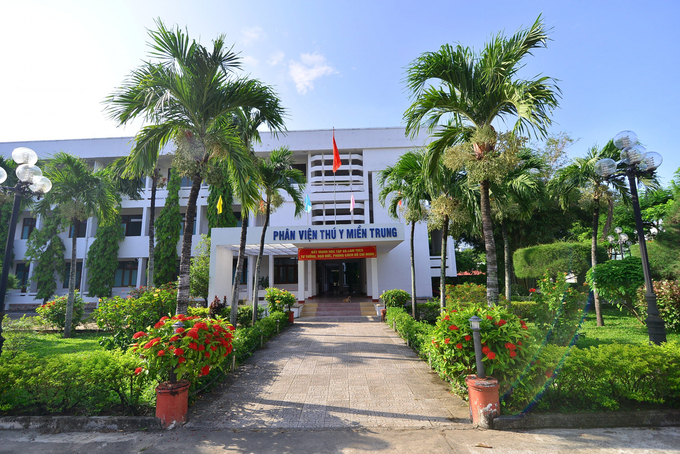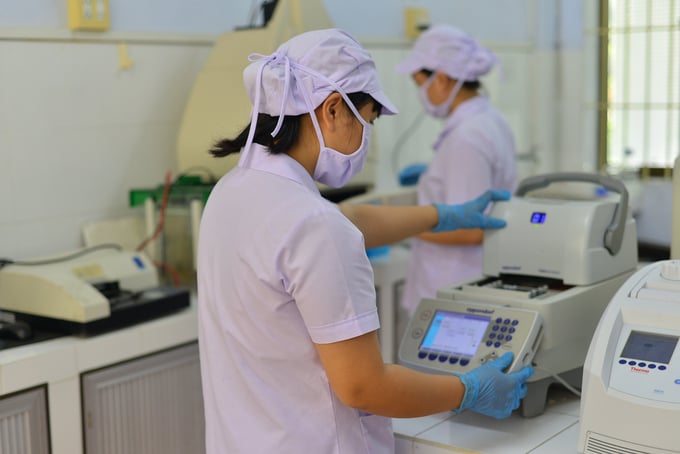The Central Institute of Veterinary Medicine in Nha Trang City, Khanh Hoa Province, after 45 years of construction and development, is increasingly asserting its position and role in the development of the country’s agricultural industry and actively contributing to the process of international integration.

Seat of the Central Institute of Veterinary Medicine. Picture: Min Hau.
Breakthrough of the switching drive
In 2007, implementing the renewal and development strategy in line with Party and State guidelines, based on actual operation, the Institute officially changed its operating mechanism from planned to active operation, autonomy and ownership. In 2012, the sub-institute built a high-tech vaccine research and production facility that met GMP-WHO standards with a total value of VND 90 billion. In 2017, the sub-institute continued to invest in the construction of a new product development and testing facility, and then built a breeding area for laboratory animals.
In 2018, the Central Institute of Veterinary Medicine was recognized by the Ministry of Agriculture and Rural Development as a science and technology organization that can self-fund recurring expenses and investments. The transformation of the surgical method towards an autonomous and responsible mechanism is a milestone in the groundbreaking development of the device. This transformation has created favorable conditions for the Institute to promote its existing strengths to gradually develop into a strong research, diagnostic, production and business entity, while maintaining the Institute’s position and role in the development of the agricultural sector as a to confirm and an active contribution to the overall development of the country.

The Central Institute for Veterinary Medicine has a modern vaccine production facility. Picture: Min Hau.
associate Prof. Dr. Production of medicines and vaccines against epidemics according to plan. During this time, the Sub-Institute has closely followed the assigned roles and tasks and successfully completed the practical requirements outlined. In 2009, the Ministry of Agriculture and Rural Development commissioned the Central Veterinary Sub-Institute to conduct research into aquatic pathology and biotechnology. So far, the institute has performed 6 tasks.
At present, the Central Institute of Veterinary Medicine has a total number of officials and staff of over 100 people, including 16 doctors, 18 masters, 24 staff with university degrees. The Institute has built a team of highly skilled staff to meet the needs of vaccine research and manufacturing. Together with a team of highly qualified employees, the Central Institute of Veterinary Medicine has invested in the construction of a modern facility and factory that complies with GMP-WHO standards. The laboratory system is ISO:17025 compliant, is recognized as a Level II Biosafety Laboratory and is designated an Agriculture and Rural Development Laboratory by the Department of Agriculture and Rural Development.
A reliable address for scientists and farmers
In over 45 years of construction and development, the Central Sub-Institute of Veterinary Medicine, with many years of achievements in scientific research and education in conjunction with production and business, has created many useful products for society and trusted address of many scientists and farmers across the country.
Research topics and products from research results have increased qualitatively and quantitatively in recent years. Many research products have been scaled up to industrial scale, such as E.g.: triple vaccine to prevent pasteurellosis, paratyphoid and swine fever; Antitoxin vaccine for prevention of necrotizing enterocolitis in goats, sheep and cows; E.coli vaccine for the prevention of swine edema disease, dual vaccine for the prevention of swine fever and convulsive disease, dual vaccine for the prevention of head edema and paratyphoid in swine; Gumboro disease vaccine in chickens…

Vaccine research is particularly interested at the Central Institute of Veterinary Medicine. Picture: Min Hau.
The research results are published in national and international journals to disseminate scientific knowledge and disseminate scientific knowledge. Every year 7-8 articles are published in domestic journals and 3-4 articles in international journals.
In addition to performing functions and tasks, the Central Institute for Veterinary Medicine promotes international cooperation to develop scientific and technological potential. Recently, the unit invited foreign experts to work and signed bilateral projects with many countries such as Australia, Taiwan, Korea, Belgium, USA, Denmark, Italy… At the same time, it sends civil servants to study abroad to improve capacity.
Currently, the Central Institute for Veterinary Medicine flexibly combines scientific research and animal disease diagnostics with the criteria of fast, timely and accurate diagnostic tests. Rapidly and accurately diagnosed patient samples have greatly contributed to preventing the spread of disease to livestock and to economic and social stability.
Another focus of the Central Institute for Veterinary Medicine is the manufacture and sale of veterinary medicines. This is identified as one of the important political tasks of the entity and as one of the crucial factors for the stability and development of the institute. So far, the sub-institute has been able to bring its research advantages together with application and technology transfer to production in a meaningful way and thus open up and expand the market.

Vaccine products from the Central Institute of Veterinary Medicine are highly valued by breeders. Picture: Min Hau.
The unit’s vaccine products are increasingly being welcomed by farmers in the region and across the country. Throughout its 45 year journey, the institute has focused on building a movement to emulate good work and building a strong union organization alongside continuous professional development. Cultural and artistic activities, especially sports movements, are always aimed at organization. These activities ensure the mental life and health of civil servants and employees, and create solidarity and participation. Activities such as sightseeing, tourism and relaxation are always organized by the institute. The material life of cadres, officials and employees has always been taken care of and guaranteed.
The Central Institute of Veterinary Medicine was honored to receive the award for outstanding achievements in improving the quality of products and services, competitiveness and operational efficiency, and integration into the regional and world economy. The Prime Minister awarded the National Quality Gold Award in 2016. Many of the institute’s vaccine products won the Vietnam Golden Rice Award, Agricultural Gold Cup and Good Vietnamese Goods, voted for by consumers.
With great achievements and contributions over the past 45 years, the institute has been highly appreciated by the party, the state, all levels and sectors, and has been awarded many noble prizes. In 1983 the Central Institute of Veterinary Medicine was awarded the Third Class Labor Medal; In 1987 he received the Second Class Labor Medal; In 2003 he received the first-class Labor Medal and in 2010 he was honored to receive the third-class Independence Medal. In addition, the Central Institute of Veterinary Medicine has repeatedly received the emulation flag and certificate of merit from the government, the Ministry of Agriculture and Rural Development, the People’s Committee of Khanh Hoa Province…
“The Central Institute for Veterinary Medicine will continue to focus on the requirements of practice in the coming period in order to advance scientific research and create high-quality, single-variety products. These are vaccines used to prevent diseases in animals, livestock and aquatic animals. At the same time, you constantly train human resources, expand international cooperation, learn and apply new science and technology. As a result, the spiritual and material life of civil servants and employees is constantly being improved, and more and more of it contributes to the state budget.
(Prof.Dr. Vu Khac Hung)

